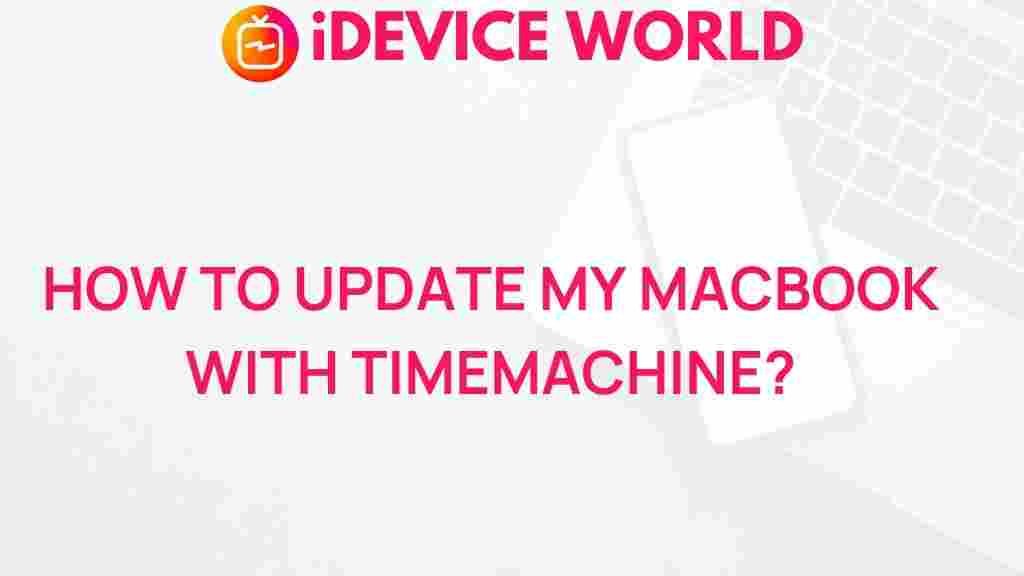Unleash the Power of Time Machine
Updating your MacBook can often feel like a daunting task, especially with all the important data and settings you have stored. Fortunately, with Time Machine, Apple’s built-in backup feature, the process becomes much smoother. This guide will walk you through how to effectively use Time Machine to back up your files before updating your MacBook, ensuring you don’t lose any critical information in the process.
What is Time Machine?
Time Machine is a backup software application distributed with macOS, which makes it easy for users to back up their entire system. It allows you to automatically back up your files, apps, system settings, and everything else you might need. It’s an invaluable tool for safeguarding your data before performing any major updates.
Benefits of Using Time Machine
- Automatic Backups: Once set up, Time Machine runs automatically in the background, ensuring your data is consistently backed up.
- Easy Restoration: You can easily restore individual files or your entire system from a backup.
- Incremental Backups: Only changes are backed up after the initial backup, saving storage space and time.
- Historical Versions: Allows you to access and restore older versions of files.
Preparing Your MacBook for the Update
Before you start the update process, ensure that your MacBook is ready. Here are the steps to prepare your device:
Step 1: Check Your macOS Version
Start by verifying the current version of macOS you are running:
- Click on the Apple icon in the top left corner.
- Select “About This Mac.”
- Note the version number displayed in the window.
Step 2: Free Up Space
Make sure you have enough free space on your MacBook to accommodate the new update. Generally, it’s advisable to have at least 20% of your total disk space free.
Step 3: Connect to Wi-Fi
A stable internet connection is crucial for downloading updates. Ensure your MacBook is connected to a reliable Wi-Fi network.
Using Time Machine for Backup
Now that you have prepared your MacBook, it’s time to set up Time Machine for backing up your data. Follow these steps:
Step 4: Connect an External Storage Device
To use Time Machine, you need an external hard drive or a network-attached storage (NAS) device. Here’s how to connect:
- Plug your external hard drive into your MacBook via USB or connect to your NAS over the network.
- Make sure the drive is formatted for macOS (Mac OS Extended or APFS).
Step 5: Set Up Time Machine
Once your external drive is connected, follow these steps to set up Time Machine:
- Go to the Apple menu and select “System Preferences.”
- Click on “Time Machine.”
- Toggle the switch to “On.”
- Select your external drive from the list as the backup disk.
Step 6: Start the Backup
After setting up Time Machine, initiate the first backup:
- Click on “Back Up Now” in the Time Machine menu.
- Wait for the backup to complete, which may take some time depending on the amount of data you have.
Step 7: Verify the Backup
Once the backup is complete, verify that it has been successful:
- Click on the Time Machine icon in the menu bar.
- Select “Enter Time Machine.”
- Browse through the backed-up files to ensure everything is in order.
Updating Your MacBook
With your data securely backed up using Time Machine, you can now proceed with the update:
Step 8: Check for Updates
To check for updates, follow these steps:
- Go to the Apple menu.
- Select “System Preferences.”
- Click on “Software Update.”
- Your Mac will check for available updates.
Step 9: Install the Update
If updates are available, you will see options to update. Click “Update Now” to begin the installation process.
- Follow the on-screen instructions.
- Your Mac may restart multiple times during the process.
Step 10: Monitor the Installation
Keep an eye on the installation progress to ensure there are no issues. The update could take anywhere from a few minutes to an hour, depending on the size of the update and your MacBook model.
Troubleshooting Common Issues
If you encounter problems during the update or backup process, consider the following troubleshooting tips:
Problem 1: Time Machine Backup Fails
- Ensure that the external drive is connected properly.
- Check that the drive is formatted correctly for macOS.
- Restart your Mac and try backing up again.
Problem 2: Update Stalls or Fails
- Ensure your MacBook has a stable internet connection.
- Check for available disk space; you may need to free up more space.
- Restart your Mac and attempt the update again.
Problem 3: Unable to Restore Files
- Make sure you are accessing the correct backup in Time Machine.
- Try searching for specific files instead of browsing through the backups.
- Check if the backup drive is functioning properly.
Conclusion
Updating your MacBook doesn’t have to be a stressful experience. By leveraging Time Machine to back up your data, you can confidently proceed with the update, knowing your files are safe. Following the steps outlined in this guide will help you maximize the benefits of Time Machine and ensure a smooth transition to the latest version of macOS.
For more detailed information on managing your backups and updates, check out Apple’s official documentation here. By keeping your system updated and backed up, you’ll enhance your MacBook’s performance and security.
Stay connected with us for more helpful tips on maximizing your MacBook experience!
This article is in the category Guides & Tutorials and created by iDeciveWorld Team
